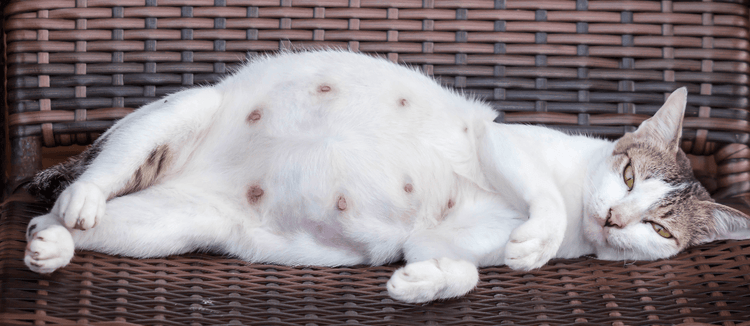
Cats and Mating: What Do You Need to Know?
An integral part of feline social behavior revolves around sexual reproduction. Sexual development in cats begins at puberty. The age at which puberty begins differs between the sexes and between individuals and breeds.
Sexual and sex-linked behaviors are important to males and females with respect to procreation. It is important to understand the form that these behaviors take in adults and to realize that they are not always completely abolished by neutering. Also, it is useful to note that sexually dimorphic behaviors (behaviors considered typical to a particular sex) are not unique to males or females. Rather, these behaviors are expressed to a greater degree in one sex or the other.
Estrus in the queen (female cat) is defined as the time during the reproductive cycle when she displays interest in mating. Estrus begins when the queen allows the male to mount and breed, and ends when her receptive behavior ceases. In cats, mating behavior is required to induce ovulating.
Domestic cats usually reach sexual maturity (puberty) between five to 12 months, at which time they experience their first estrus. The adult cat is seasonally polyestrus, cycling repeatedly (about every two to three weeks) throughout the breeding season (mid-January to August), unless interrupted by pregnancy or illness. Several major phases compose the estrous cycle, and variations in the level of normal circulating hormones contribute to these different phases.
Estrus is a normal physiologic function of the intact female cat. Estrus can be prevented or eliminated by spaying the cat. The medical term for spaying is ovariohysterectomy, which means that both the ovaries and uterus of the cat are surgically removed. All signs of estrus cease within a few days of spaying the cat.
There are certain hormonal changes in the cycling queen until she mates. Estrogen is responsible for the queen’s going into heat and progesterone is necessary for pregnancy. When the estrogen concentration rises, the queen goes into heat, and when it drops, the heat ends. Until the queen is mated, this rise and fall of estrogen will continue.
Cats and Mating: How it Happens
Since the female is less sensitive to environmental changes when in heat, she is brought to the tom for breeding. Once the cats get together, the mating process doesn’t last very long – only about half of a minute to about 4 minutes. First the male bites the female’s neck, mounts her and positions himself on top of her. He then thrusts his pelvis into her and finally penetrates her, which usually only lasts about 4 seconds.
During this last phase or shortly thereafter, the female will scream and attempt to break free by turning, rolling or striking the male with her paw. Then she will have a so-called “after-reaction” where she’ll roll or thrash and clean herself. This after-reaction may last up to 9 minutes.
The time intervals between matings may be as short as 5 minutes or as long as half an hour. A female may allow up to 30 matings, and studies have shown that if only one single mating is allowed only 50 percent of the queens will get pregnant. Queens are not too particular. They will allow mating will various males and this can result in a variety of different fathers for the same litter. Each kitten has only one father and kittens within the same litter may all have different fathers.
If you are not looking forward to the pitter-patter of little paws, there is a simple solution: Neuter or spay your pet. For cats, the most reliable and effective method for birth control is the removal of the reproductive organs.
For some people, however, the procedure is too permanent. They may want their pet to breed some time in the future, and are looking for a way to suppress the sex drive. Two medications — progestin and mibolerone — have been shown to suppress the reproductive drive, but they are only effective in the female. So far, there is no medication that can suppress the libido in male cats.
Cats and Mating: How to Tell if Your Cat is Pregnant
It happens before you know it. You turn around and the cute little kitten that you just got yesterday is having a litter of kittens of her own. As most people know, cats are quite good at reproducing. In fact, the average size of a litter is four kittens. For Siamese cats, it’s even higher — six kittens. And that’s just the average. But remember, it’s a good idea to get your cat spayed or neutered as soon as he/she is old enough. Otherwise, you could have a lot of homeless kitties on your hand. Only leave your cat intact if she’s a purebred and you plan on breeding her.
It takes about 26 to 35 days from the time your cat gets pregnant for a veterinarian to tell for sure. The diagnosis can be made by ultrasound or by feeling the abdomen of your cat — or the queen, as she’s called when she’s “with kittens.” The uterus area should feel like a string of pearls. At about 20 days, you should be able to feel the small fetuses if your cat is relaxed. Some cats will show enlargement and a pink color of their mammary glands as early as the 18th day of pregnancy. A cat is usually pregnant for 58 to 68 days.